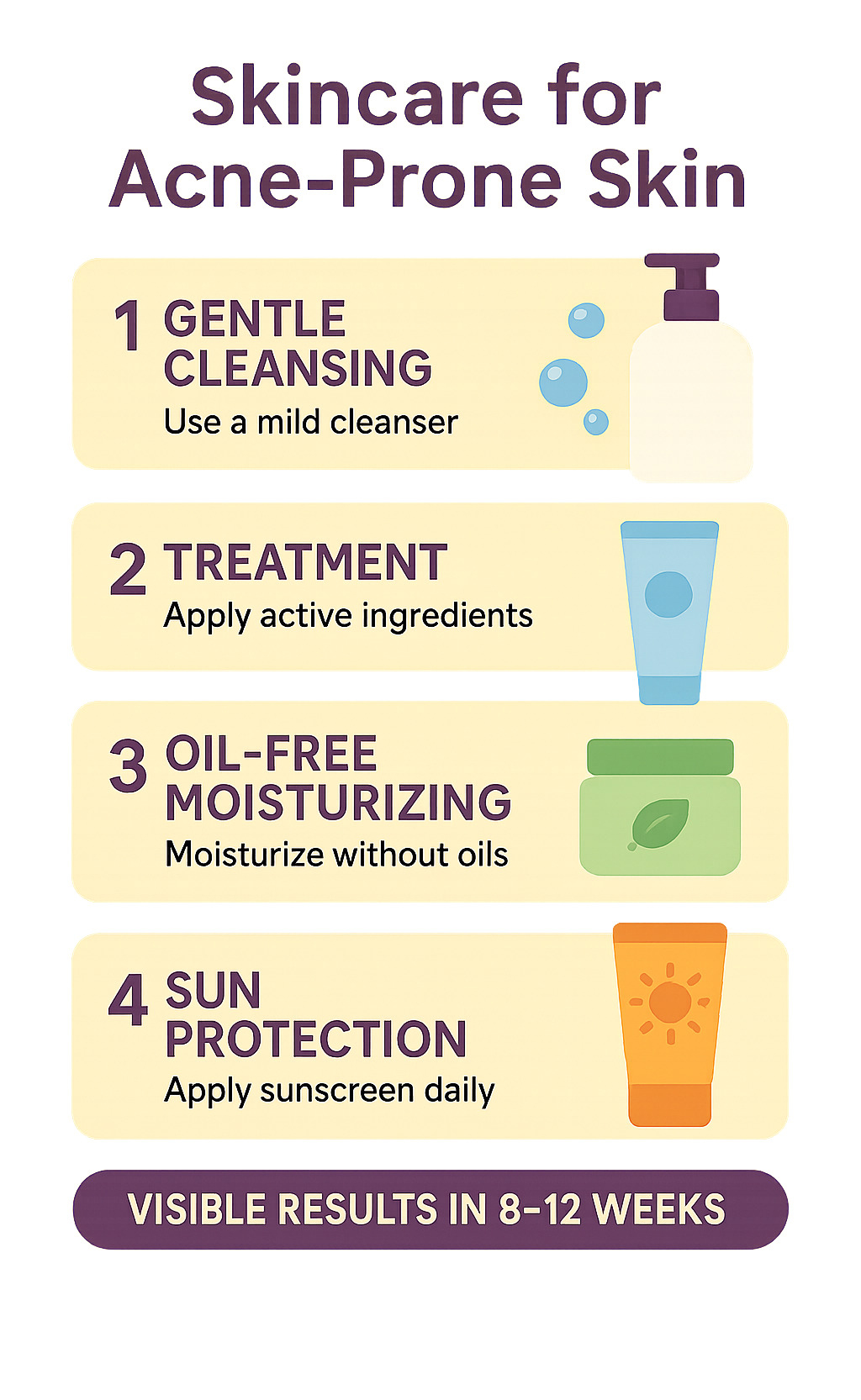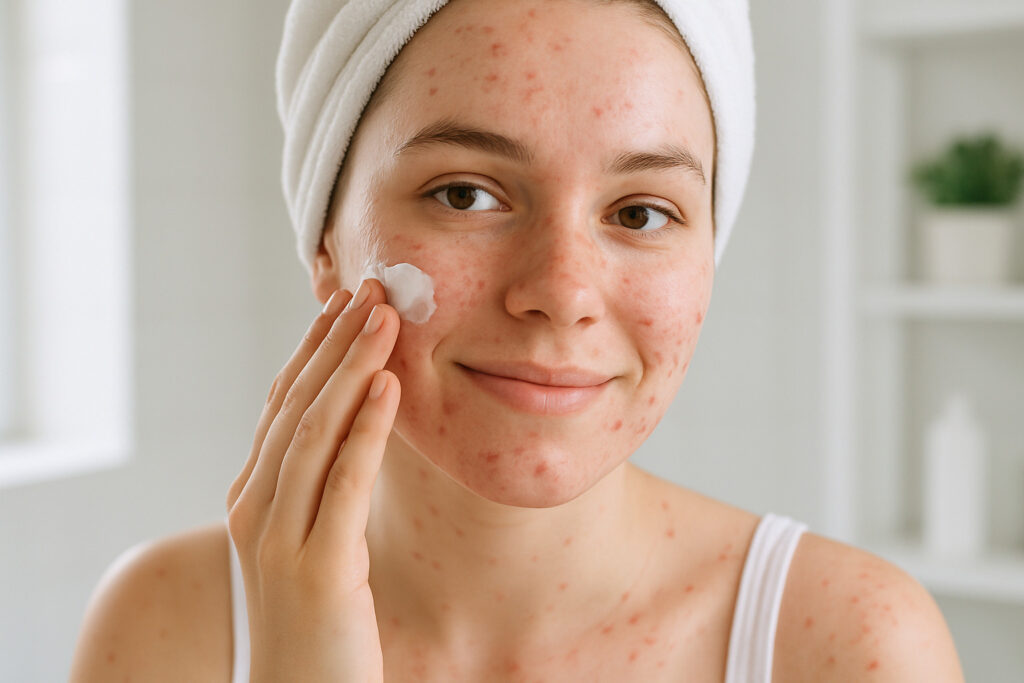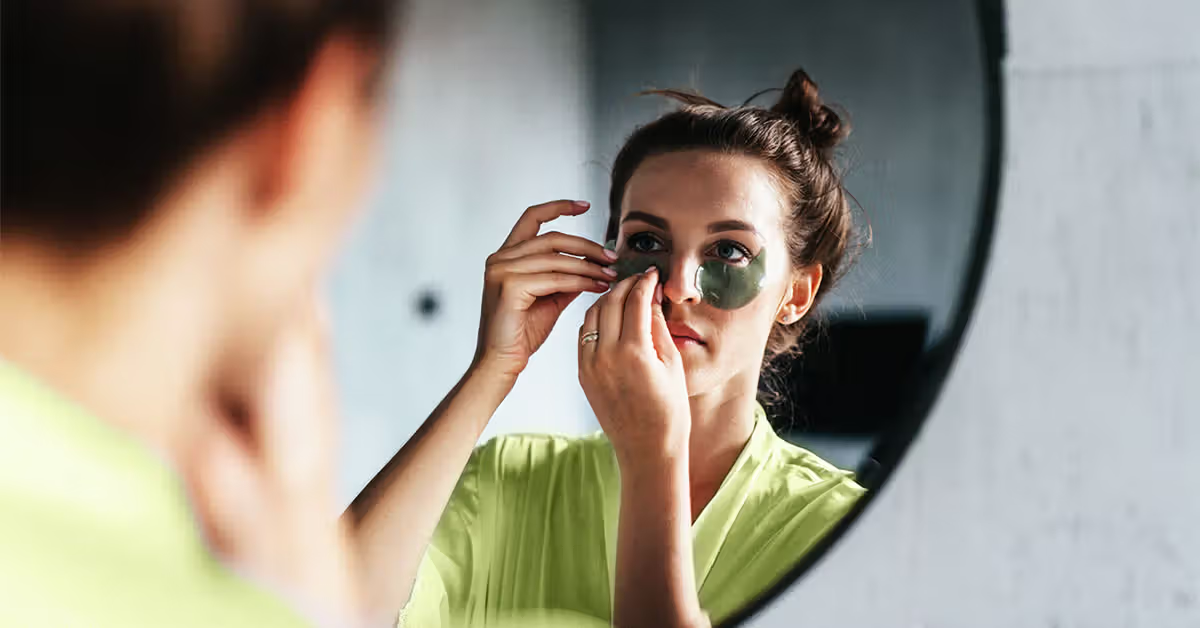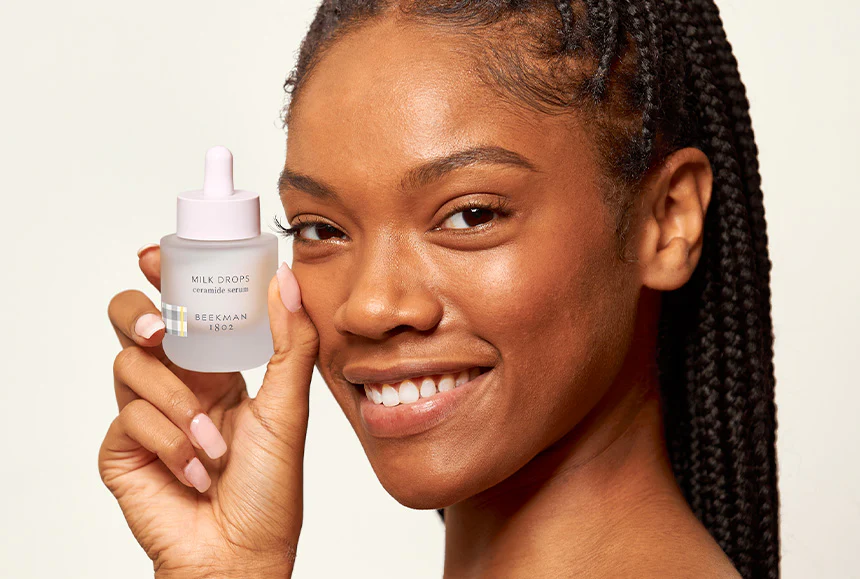Understanding Acne-Prone Skin: The Basics
Let’s face it—acne can be frustrating. If you’re among the 50 million Americans dealing with breakouts each year, you’re certainly not alone. The good news? Skincare for acne-prone skin doesn’t have to be complicated or overwhelming.
Think of acne care as a simple four-part harmony rather than a complex symphony:
| Essential Step | Key Ingredients | Best Practices |
|---|---|---|
| Cleanse | Salicylic acid (0.5-2%), Benzoyl peroxide (2.5-4%) | Gentle washing twice daily |
| Treat | Benzoyl peroxide (2.5-5%), Retinoids, Azelaic acid (10%) | Start with lower strengths |
| Moisturize | Oil-free, Non-comedogenic formulas | Never skip, even with oily skin |
| Protect | Mineral-based, Oil-free SPF 30+ | Apply daily, rain or shine |
I love how Dr. Brooke Bair puts it: “Acne is not a ‘dirt’ problem.” That’s right—those breakouts aren’t appearing because you’re not washing enough! They’re the result of a complex interplay between excess oil production, dead skin cell buildup, and those pesky acne-causing bacteria.
When shopping for products, become best friends with the term “non-comedogenic” (translation: won’t clog your pores). Focus on science-backed ingredients rather than whatever’s trending on TikTok this week. Your skin will thank you!
Here’s something many people miss: patience is absolutely essential. Even the most effective acne treatments typically need 2-3 months of consistent use before you’ll see dramatic improvements. Think of it as a marathon, not a sprint.
Throughout this guide, we’ll focus on clean, effective formulations that work with your skin rather than against it. Because treating acne shouldn’t mean compromising your skin’s long-term health or the environment.

Why Some Skin Is Acne-Prone: The Science
Ever wonder why some people barely get a pimple while others battle breakouts constantly? The answer lies in the fascinating science of our skin.
Acne develops when hair follicles become clogged with oil and dead skin cells, creating the perfect environment for bacteria to throw a party – and your skin pays the price.
The main troublemakers behind those unwanted breakouts include:
Excess sebum production happens when your skin produces too much of its natural oil (sebum). Think of sebum like your skin’s built-in moisturizer – great in moderation, problematic in excess. Hormonal changes often trigger this overproduction, which is why teens and women experiencing menstrual cycles often see more breakouts.
Dead skin cell buildup occurs when your skin’s natural shedding process goes awry. Instead of flaking away, these cells stick together and form a plug in your pore – like a cork in a bottle.
Bacteria proliferation follows next. We all have Cutibacterium acnes bacteria living on our skin (yes, even people with clear complexions!). But when these bacteria get trapped in a clogged, oxygen-deprived pore with plenty of sebum to feed on, they multiply rapidly, triggering inflammation.
Inflammation is your body’s response to this bacterial invasion. The redness, swelling, and tenderness you feel is actually your immune system trying to help – though it doesn’t feel helpful when you’re sporting a painful pimple before an important event!
Different combinations of these factors create various types of acne:
| Acne Type | Appearance | Inflammation Level | Cause |
|---|---|---|---|
| Blackheads | Small, dark spots | Non-inflammatory | Open clogged pores (oxidized sebum) |
| Whiteheads | Small, white bumps | Non-inflammatory | Closed clogged pores |
| Papules | Small, tender red bumps | Inflammatory | Moderate infection in pore |
| Pustules | Red bumps with white/yellow centers | Inflammatory | Pus-filled infection |
| Nodules | Large, painful, solid lumps | Severely inflammatory | Deep infection beneath skin |
| Cysts | Large, painful, pus-filled lumps | Severely inflammatory | Deep infection that can cause scarring |
“The vast majority of people have had acne once in their lifetimes,” notes Dr. Viseslav Tonkovic-Capin, highlighting just how universal this skin condition truly is. But why do some people struggle more than others? Several factors can make your skin more acne-prone:
Genetics play a huge role in determining your skin’s oil production and how it responds to hormones. Thanks, Mom and Dad! If your parents dealt with significant acne, you may be more likely to experience it too.
Hormonal fluctuations during puberty, menstrual cycles, pregnancy, or conditions like polycystic ovary syndrome (PCOS) can trigger or worsen breakouts. These hormonal changes directly impact sebum production.
Stress increases cortisol production, which can stimulate oil glands and worsen inflammation. This explains those dreaded breakouts before important events – when you’re most stressed!

Key Internal & External Triggers
Beyond biology, your lifestyle choices and environment can significantly impact your skin’s tendency to break out. Understanding these triggers is crucial for developing effective skincare for acne-prone skin.
Internal Triggers:
Your diet may be silently contributing to breakouts. Research increasingly suggests high-glycemic foods (like white bread and sugary treats) spike insulin levels, which can increase oil production and inflammation. Dairy products contain hormones that may trigger acne in sensitive individuals. While you don’t need to eliminate entire food groups, paying attention to how your skin responds to certain foods can be illuminating.
Certain medications can cause acne as an unwanted side effect. Corticosteroids, androgens, and lithium are common culprits. If you’ve started a new medication and noticed more breakouts, speak with your doctor about possible alternatives.
Dehydration forces your body to compensate by producing more oil, potentially worsening acne. That eight-glasses-a-day rule isn’t just good for your overall health – it helps your skin too!
External Triggers:
Those gorgeous hair products might be sabotaging your skin. Heavy styling products, oils, and pomades can transfer to your skin and clog pores, especially around the hairline and forehead – dermatologists even have a name for it: “pomade acne.”
Makeup residue left overnight gives bacteria plenty of time to multiply. Even during the day, comedogenic (pore-clogging) formulas can lead to breakouts. Always remove makeup before bed and look for non-comedogenic products when shopping.
Sweat itself doesn’t cause acne, but letting it sit on your skin after a workout creates an ideal breeding ground for bacteria. Try to shower or at least cleanse your face promptly after sweating.
Friction from constantly touching your face, holding phones against your cheek, or wearing tight headgear can irritate skin and trigger what dermatologists call “acne mechanica.”
Your pillowcase might be a secret troublemaker. It collects dead skin cells, bacteria, and hair products that transfer back to your skin night after night. Changing pillowcases frequently (ideally twice weekly) can make a surprising difference.
Dr. Margarita Lolis offers this important caution: “Using too many active ingredients at once—like layering multiple treatments with AHAs, retinoids, and benzoyl peroxide—can be too harsh and irritate your skin, which can end up making breakouts worse.” This highlights why a strategic approach to treating acne is so important – sometimes less truly is more when it comes to skincare for acne-prone skin.
Understanding what triggers your unique skin helps you make smarter choices about products, habits, and treatments. For more detailed information on what causes acne, the Cleveland Clinic offers excellent research on acne triggers.
Skincare for Acne-Prone Skin: Ingredient Checklist
Let’s face it—the skincare aisle can feel like a maze when you’re dealing with breakouts. But building an effective skincare for acne-prone skin routine doesn’t have to be complicated. It’s all about knowing which ingredients actually work (and which ones might make things worse).
Exfoliating Acids
Your best friends in the battle against clogged pores are certain acids that help remove dead skin and excess oil.
Salicylic Acid is like a tiny deep-cleaning expert. This oil-soluble beta-hydroxy acid can actually dive into your pores (unlike many ingredients that just work on the surface) to dissolve the mixture of oil and dead cells that lead to breakouts. Look for concentrations between 0.5-2% in leave-on products or up to 2% in cleansers. It’s particularly effective for those pesky blackheads and whiteheads.
Glycolic Acid works differently—it’s an alpha-hydroxy acid that exfoliates the skin’s surface, improving overall texture and helping fade those annoying dark spots left behind after pimples heal. For at-home use, products with 5-10% concentration strike the right balance between effectiveness and gentleness.
Antibacterial Agents
Since bacteria play a significant role in acne formation, these bacteria-fighters are essential weapons in your skincare arsenal.
Benzoyl Peroxide doesn’t just kill acne-causing bacteria—it also helps reduce inflammation, making those angry red bumps calm down faster. Here’s a pro tip: research shows that lower strengths (2.5-5%) work just as well as higher concentrations but cause less irritation. Save the stronger 10% formulas for stubborn body acne.
Azelaic Acid is the multitasker you might not know about yet. It fights bacteria, calms inflammation, AND helps fade dark spots that linger after breakouts. It’s particularly great for those with sensitive skin or deeper skin tones prone to post-inflammatory hyperpigmentation. Look for 10% in over-the-counter products.
Cell-Regulating Ingredients
Retinoids (like adapalene and retinol) are the long-game players in acne treatment. As Dr. Mona Gohara colorfully explains, they act “like a crossing guard that keeps things moving” by normalizing how your skin cells turn over and preventing the clogging that starts the acne cycle. Start with 0.1% adapalene (now available without prescription) or lower percentages of retinol if you’re new to these powerful ingredients.
Supporting Ingredients
While the ingredients above directly target acne, these supporting players help keep your skin balanced and happy:
Niacinamide (vitamin B3) is the peacekeeper of skincare ingredients. It reduces inflammation, helps regulate oil production, and strengthens your skin barrier—all without irritation. Concentrations between 2-10% work well alongside other acne treatments.
Ceramides are natural fats that help maintain your skin’s protective barrier. Think of them as the mortar between the bricks of your skin cells. They’re especially important when using drying acne treatments, as they help prevent excessive moisture loss.
Zinc is an underrated hero for acne-prone skin. This mineral has anti-inflammatory properties and helps regulate oil production, making it particularly effective for inflammatory acne. You’ll often find it paired with niacinamide in serums and moisturizers.
What to Use & What to Skip
Creating an effective skincare for acne-prone skin routine isn’t just about what to include—it’s also about what to avoid.
Accept these skin-friendly choices:
Look for products labeled non-comedogenic (won’t clog pores) and oil-free (provides hydration without excess greasiness). Choose fragrance-free options whenever possible, as fragrances can irritate already-angry skin. Water-based textures like gels and lightweight lotions generally work better than heavy creams, and pH-balanced cleansers help maintain your skin’s natural protective barrier.
Skip these potential troublemakers:
Toners heavy in alcohol might feel good in the moment (especially if your skin is oily), but they can actually trigger more oil production by stripping your skin. Those satisfying physical scrubs with gritty particles can create micro-tears and spread bacteria. Ingredients like coconut oil and cocoa butter might be natural, but they’re highly comedogenic for most acne-prone people. And while they smell lovely, most essential oils can irritate sensitive, acne-prone skin.
One of the biggest myths about acne is that you should skip moisturizer. As Dr. Margarita Lolis points out, “Moisturizer is absolutely necessary to balance your skin’s oil production and keep your skin barrier healthy.” Your skin actually needs hydration—just make sure you’re using the right type.
Want to dive deeper into understanding skincare ingredients beyond acne treatments? Check out our comprehensive guide to Learning About Skincare Ingredients for more insights into what your products contain.
Top Picks Roundup: Build Your Breakout-Fighting Arsenal
Ready to start tackling those breakouts? Now that we understand what causes acne and which ingredients fight it, let’s talk about actual products you can use. Patience is your friend here—most people need 2-3 months of consistent use before seeing dramatic improvements.
I’ve selected recommendations based on what actually works, not just what’s trending on TikTok:
- Products with proven active ingredients at effective strengths
- Nothing that clogs pores or contains unnecessary fragrance
- Gentle formulas you can use regularly without turning your face into a desert
- Products that play nicely with your other acne treatments
Best Cleansers for Skincare for Acne-Prone Skin
Think of cleansing as setting the stage for everything that follows. A good cleanser removes the day’s buildup without stripping your skin’s natural defenses.
Salicylic Acid Cleansers work wonders because they don’t just clean the surface—they actually penetrate oil to unclog those stubborn pores. For best results, massage the cleanser gently for about 60 seconds (about the time it takes to hum “Happy Birthday” twice) before rinsing. These are perfect for all types of acne, but they really shine at tackling blackheads and whiteheads.
Benzoyl Peroxide Cleansers are bacteria’s worst nightmare, killing acne-causing culprits within seconds of contact. Start with a 4% formula before diving into higher strengths, and let it sit on your skin for a minute or two before rinsing. Just be careful around your towels and pillowcases—BPO is notorious for bleaching fabrics! These cleansers are particularly effective for inflammatory acne (those red, angry bumps).
Sometimes, your skin needs a gentler approach, especially in the morning or when you’re using strong treatments elsewhere in your routine. Non-Medicated Cleansers with ceramides and glycerin support your skin barrier while still getting you clean. Think of these as the gentle foundation of your skincare for acne-prone skin routine.
A quick note about pH: our skin naturally sits at a slightly acidic 4.5-5.5 pH level. Cleansers with a similar pH help maintain this healthy balance, while harsh, alkaline soaps can disrupt it and potentially make your acne worse.
Power Exfoliants & Leave-On Acids
Exfoliation is non-negotiable for skincare for acne-prone skin. Those dead skin cells that pile up? They’re like catnip for breakouts. But put down that harsh scrub—chemical exfoliants are generally much kinder to acne-prone skin.
BHA (Salicylic Acid) Exfoliants are oil-soluble, meaning they can cut through the grease and dive deep into pores to dissolve clogs. Apply to clean, dry skin and start slow—2-3 times weekly is plenty until your skin adjusts. These are particularly brilliant for oily skin types and preventing those tiny blackheads before they form.
AHA Exfoliants work on the skin’s surface to gently dissolve the “glue” holding dead skin cells together. They’re excellent for improving texture and fading those stubborn post-acne marks. One important note: always use sunscreen the morning after applying AHAs, as they make your skin more sun-sensitive.
For the efficiency-minded, Combination Exfoliating Pads deliver multiple acids in one convenient swipe. They’re perfect for busy mornings or travel when you don’t want to pack your entire skincare cabinet.
If your skin tends to be sensitive, Weekly Enzyme Masks offer a gentler alternative. These masks use fruit enzymes to dissolve dead skin cells without harsh acids. A thin layer for 10-15 minutes once a week can make a noticeable difference without irritation.
Remember Dr. Lolis’s wise words about over-exfoliation: “Using too many active ingredients at once can be too harsh and irritate your skin, which can end up making breakouts worse.” When it comes to exfoliation, more isn’t better—consistency is.
Targeted Treatments & Retinoids
For those persistent breakouts and long-term prevention, targeted treatments deliver higher concentrations of active ingredients exactly where you need them.
Adapalene Gels (a type of retinoid) are one of dermatologists’ favorite recommendations because they normalize cell turnover to prevent clogged pores while also calming inflammation. Start with just a pea-sized amount for your entire face 2-3 nights a week, gradually increasing frequency as your skin adjusts. As Dr. Gohara explains, retinoids work like “a crossing guard that keeps things moving” in your oil glands. Always pair with daytime sunscreen protection.
Benzoyl Peroxide Treatments remain one of the most effective ways to kill acne-causing bacteria. Contrary to popular belief, research shows that lower strengths (2.5%) work just as well as higher percentages with fewer side effects. Apply a thin layer to problem areas or across your entire face if breakouts are widespread.
Azelaic Acid Suspensions might not get as much hype, but they’re remarkably effective—especially for those with darker skin tones dealing with post-acne dark spots. With antibacterial, anti-inflammatory, and brightening properties all in one ingredient, a 10% formula can tackle active breakouts while fading the marks left behind.
For those emergency situations (like a pimple before a big event), Sulfur Spot Treatments can help reduce oil and provide mild antibacterial action. They’re not for long-term use but can be lifesavers for occasional spot-treating.
Barrier-Friendly Moisturizers for Skincare for Acne-Prone Skin
Let’s bust a major myth right now: if you have acne, you absolutely still need moisturizer. In fact, skipping this step can actually make your oil production worse! When skin becomes dehydrated, it often produces more oil to compensate, potentially causing more breakouts.
Oil-Free Gel Moisturizers are perfect for those who hate the feeling of traditional creams. They sink in quickly, provide hydration without greasiness, and often have a refreshing feel that oily skin types love. Apply to slightly damp skin after treatments to lock in hydration.
Ceramide-Rich Lotions are especially important when you’re using drying acne treatments. Ceramides help repair and maintain your skin barrier—think of them as the mortar between your skin cell “bricks.” When this barrier is intact, your skin retains moisture better and is less reactive to irritants.
Niacinamide Moisturizers offer multiple benefits for acne-prone skin. This powerhouse ingredient helps regulate oil production while simultaneously reducing inflammation and redness. It’s like a Swiss Army knife for combination skin types.
For those who struggle with midday shine, Mattifying Moisturizers contain ingredients that absorb excess oil throughout the day. These are particularly helpful in hot, humid climates or on long days when you can’t stop to blot or touch up.
Always check that your moisturizer is labeled “non-comedogenic” and steer clear of heavy ingredients like petrolatum, mineral oil, or coconut oil, which can trap bacteria and sebum in pores.
Everyday Sunscreens & Bonus Tools
Sunscreen isn’t optional in skincare for acne-prone skin—especially when using ingredients like retinoids and AHAs that increase sun sensitivity. Beyond preventing skin cancer and premature aging, consistent sun protection helps prevent those post-acne dark spots from becoming more pronounced.
Mineral Sunscreen Fluids with zinc oxide and titanium dioxide sit on the skin’s surface without clogging pores. Bonus: zinc also has anti-inflammatory properties that can help calm acne. Apply as the final step in your morning routine and reapply every two hours when outdoors.
If you dislike the potential white cast of mineral formulas, modern Oil-Free Chemical Sunscreens offer high protection in lightweight, nearly invisible formulations. Just make sure to look for oil-free, non-comedogenic options specifically designed for acne-prone skin.
Beyond the daily essentials, several innovative tools can boost your routine. Hydrocolloid Patches have become incredibly popular for good reason—they absorb fluid from pimples while creating a protective barrier against bacteria and your own picking fingers. Apply to clean, dry skin over individual pimples and leave on for 6-12 hours.
For a high-tech approach, LED Blue Light Devices target and kill acne-causing bacteria beneath the skin’s surface. These at-home devices can be particularly helpful for supplementing topical treatments, especially for persistent breakouts that don’t seem to respond to creams alone.
Consistency with your chosen products is more important than constantly switching to the newest thing. Give your routine time to work—your future clear-skinned self will thank you!
How to Put It All Together: A Simple Daily Routine
Creating an effective skincare routine for acne-prone skin doesn’t need to feel like rocket science. The magic happens with consistency and patience—not with a bathroom counter overflowing with products. Let’s break down a straightforward approach that actually works:
Morning Routine
Start your day with gentle care. Your morning routine should focus on protection and preventing new breakouts.
Begin with a splash of lukewarm water or a gentle cleanser—harsh scrubbing first thing can trigger more oil production. If your skin tends to be oilier, a low-percentage salicylic acid wash can help keep pores clear throughout the day.
After cleansing, apply a light treatment like azelaic acid or niacinamide serum. These ingredients fight inflammation without making your skin more sensitive to sunlight—perfect for daytime use.
Next, reach for an oil-free, non-comedogenic moisturizer. Yes, even oily skin needs hydration! When skin lacks moisture, it often produces more oil to compensate.
Finally, never skip sunscreen. Choose a broad-spectrum SPF 30+ formulated specifically for acne-prone skin. Many acne treatments increase sun sensitivity, making this step non-negotiable.
Evening Routine
Evenings are the perfect time to use your more powerful treatments since you don’t have to worry about sun exposure.
First, thoroughly remove makeup with a gentle remover if needed—leftover makeup is a common culprit behind stubborn breakouts. Follow with a medicated cleanser containing either benzoyl peroxide (to kill bacteria) or salicylic acid (to dissolve oil and dead skin).
After cleansing, apply your most potent active ingredient. This might be adapalene (a retinoid) or a BHA exfoliant. Use just a pea-sized amount—more isn’t better when it comes to these powerful ingredients.
Finish with a ceramide-rich moisturizer to support overnight skin barrier repair. This step becomes especially important when using drying acne treatments, as it helps prevent the irritation that can trigger more breakouts.
Weekly Additions
Think of these as your skin’s special treatment sessions, not everyday necessities.
Extra exfoliation once or twice weekly can help prevent the buildup that leads to breakouts. Try an AHA treatment or enzyme mask for deeper exfoliation, but don’t use these on the same nights as your retinoids.
Those tiny hydrocolloid patches work wonders on active pimples. They absorb fluid while creating a protective barrier that prevents picking—a win-win for healing. Apply them to clean, dry skin before bed.
A gentle clay mask once weekly can help absorb excess oil without stripping your skin. The key word is gentle—avoid those that leave your face feeling tight and uncomfortable.

Important Tips for Success:
Patience truly is a virtue when treating acne. Resist the urge to try everything at once—your skin will thank you. Introduce just one new product at a time, waiting at least 1-2 weeks before adding another active ingredient to your routine.
When starting potent ingredients like retinoids or BHAs, begin slowly. Use them just 2-3 times per week, gradually increasing as your skin builds tolerance. Think of it as training for your skin—you wouldn’t run a marathon without building up your endurance first!
Give your routine time to work. Most people don’t see significant improvement until the 2-3 month mark. You might even experience “purging” initially as clogs come to the surface—this isn’t failure, it’s progress.
Listen to your skin. If it becomes red, dry, or irritated, scale back to just the basics: gentle cleanser, moisturizer, and sunscreen until your skin recovers. As Dr. Lolis emphasizes, “Moisturizer is absolutely necessary to balance your skin’s oil production and keep your skin barrier healthy.”
Consistency matters more than complexity. A simple routine you can maintain every day yields better results than an elaborate routine you follow sporadically. For more insights on keeping things simple yet effective, check out our guide to a Minimalist Skincare Routine.
The journey to clearer skin is a marathon, not a sprint. Be kind to your skin—and to yourself—along the way.
Frequently Asked Questions about Acne-Prone Skincare
How long before I see results?
When it comes to treating acne, patience truly is a virtue. Most dermatologists agree that you’ll need to give your skincare for acne-prone skin routine at least 8-12 weeks of consistent use before seeing dramatic improvements.
During those first few weeks, don’t be alarmed if you experience what’s called a “purge” – a temporary increase in breakouts. This happens because the active ingredients are speeding up your skin’s cell turnover, bringing already-forming clogs to the surface faster. It’s actually a sign your products are working!
How can you tell if your routine is making progress? Look for these encouraging signs:
– Your skin develops fewer new breakouts
– Existing pimples heal more quickly than before
– Redness and inflammation begin to calm down
– Your overall skin texture gradually becomes smoother
If you’ve been diligently following your routine for a full 12 weeks and see absolutely no improvement, it might be time to switch up your approach or consult with a skincare professional.
When should I see a dermatologist?
While many of us can successfully manage mild to moderate acne with over-the-counter products, there are definitely situations where professional help isn’t just helpful – it’s necessary.
Consider booking that dermatologist appointment if you’re experiencing:
Deep, painful cysts or nodules that don’t respond to your current routine. These deeper forms of acne often require prescription-strength treatments and can lead to scarring if not properly addressed.
Any type of scarring, whether they’re indented scars (ice pick, boxcar, or rolling scars) or raised scars. The sooner you treat potential scarring, the better your long-term results.
Widespread breakouts covering large portions of your face, chest, back, or other body areas often benefit from systemic approaches that only a doctor can prescribe.
Significant emotional distress from your skin condition. When acne affects your self-confidence, social life, or mental wellbeing, that’s reason enough to seek professional help.
Clear hormonal patterns to your breakouts, especially when accompanied by other hormonal symptoms. Hormonal therapies might be appropriate in these cases.
No improvement after 3 months of consistent, appropriate over-the-counter treatment. Sometimes our skin needs the extra help that only prescription options can provide.
A dermatologist has several powerful tools in their arsenal that aren’t available over the counter, including stronger topical treatments, oral antibiotics, hormonal therapies like spironolactone, or isotretinoin for severe cases. They can also perform in-office procedures like cortisone injections for painful cysts or recommend appropriate treatments for acne scarring.
Can sensitive or darker skin use these actives?
Absolutely yes – but with some thoughtful modifications to your approach. Skincare for acne-prone skin needs to be customized for your specific skin needs.
If you have sensitive skin:
Start with gentler formulations and lower concentrations of active ingredients. Your skin will thank you for the gradual introduction! Begin using new products just once or twice weekly, slowly building up as your skin develops tolerance.
Try the “buffering” technique – apply a thin layer of moisturizer before your treatment product to reduce potential irritation. Look specifically for products labeled for sensitive skin, which typically contain soothing ingredients alongside actives.
Azelaic acid deserves special mention here – it’s often remarkably well-tolerated by sensitive skin while still effectively fighting acne.
If you have a darker skin tone:
One of your biggest concerns might be post-inflammatory hyperpigmentation (PIH) – those stubborn dark spots that linger long after the pimple has healed. Azelaic acid is particularly beneficial for darker skin tones because it pulls double duty – treating both active acne and fading hyperpigmentation.
Be a bit cautious with benzoyl peroxide, which can occasionally cause temporary discoloration on deeper skin tones. If you do use it, start with lower concentrations.
Retinoids are excellent multi-taskers for darker skin, addressing both acne and hyperpigmentation, but introduce them slowly to minimize irritation.
Perhaps most importantly, never skip sunscreen! Sun exposure can dramatically darken post-acne marks, especially in deeper skin tones.
For both sensitive skin and darker skin tones, patch testing is your best friend. Before applying any new product to your face, test a small amount behind your ear or on your inner forearm for 24-48 hours to check for any adverse reactions.
With the right approach, effective acne treatment is possible for all skin types – it’s just about finding the right balance for your unique skin.
Conclusion
Managing skincare for acne-prone skin isn’t a quick fix—it’s a journey that rewards patience, consistency, and informed choices. Now that you understand the science behind breakouts and the ingredients that actually work, you’re equipped to build a routine that delivers results without unnecessary complexity.
Remember these five pillars of successful acne care:
Focus on science-backed ingredients. The research is clear: salicylic acid dissolves clogs, benzoyl peroxide fights bacteria, retinoids normalize cell turnover, and azelaic acid calms inflammation while fading dark spots. These workhorses deserve a place in your routine before trendy, unproven alternatives.
Accept simplicity. Your skin doesn’t need an elaborate 10-step routine to heal. A thoughtful four-step approach—cleanse, treat, moisturize, protect—often yields better results than complicated regimens that overwhelm both your skin and your schedule.
Give treatments time to work. Those before-and-after photos on social media rarely show the 8-12 weeks of consistent use between images. Your skin cells need time to cycle through their natural renewal process, so stick with your routine even when results aren’t immediate.
Don’t overlook lifestyle factors. Even the perfect product lineup can’t compensate for sleeping on a pillowcase that hasn’t been washed in weeks or the habit of resting your chin in your hands throughout the day. Small habits make a big difference.
Nurture your skin barrier. Treating acne doesn’t mean punishing your skin. Even oily, breakout-prone complexions need moisture and sun protection to function properly—skipping these steps often backfires by triggering more oil production.
At Beyond Beauty Lab, we believe effective skincare should work with your skin, not against it. The most powerful routines combine evidence-based ingredients with gentle, clean formulations that respect both your skin’s health and our planet’s wellbeing.
Everyone’s skin tells a different story. What clears one person’s acne might not work for yours, so don’t be afraid to adjust your approach (carefully) until you find your perfect match. If severe or persistent acne is affecting your confidence or comfort, a dermatologist can offer prescription-strength solutions that might be the turning point in your journey.
Clear skin isn’t just possible—it’s probable with the right approach and a little patience. The consistent care you show your skin today creates the healthier complexion you’ll thank yourself for tomorrow.
For more guidance on building effective routines with fewer products, visit our guide to minimalist skincare routines. And if you’re looking to make more environmentally conscious choices while treating your skin, explore our recommendations for clean beauty brands that deliver results without compromise.







